Medical Disclaimer: This article is for informational purposes only and does not replace professional veterinary advice. Always consult your vet before changing your dog’s diet.
Table of Contents
Introduction
Making homemade dog food recipes for your furry friend can be one of the most fulfilling ways to support their health—when done right. As a Canadian veterinarian, I’ve seen firsthand how customized, vet-approved meals can benefit dogs at every life stage. Whether it’s a wiggly puppy with boundless energy, a healthy adult with a steady routine, or a senior who needs extra TLC, your dog’s nutritional needs change over time. This guide walks you through safe, balanced, and practical homemade dog food recipes tailored for puppies, adults, and senior dogs.
Key Takeaways: Homemade Dog Food Recipes by Life Stage
- Dogs have different dietary needs at every age. Puppies need calorie-rich meals with extra calcium and protein; adults need balanced maintenance; seniors benefit from higher protein and softer, hydrating foods.
- Each recipe in this guide is vet-approved and backed by science, using trusted standards like AAFCO and NRC for nutrient guidelines.
- Supplements are critical—even high-quality homemade dog food recipes can be nutritionally incomplete without added vitamins and minerals.
- We include tips on ingredients to avoid, portion sizes, Canadian cost estimates, and home prep safety to help you serve fresh meals with confidence.
- Consult your vet before making a diet change, especially for puppies or dogs with health conditions.
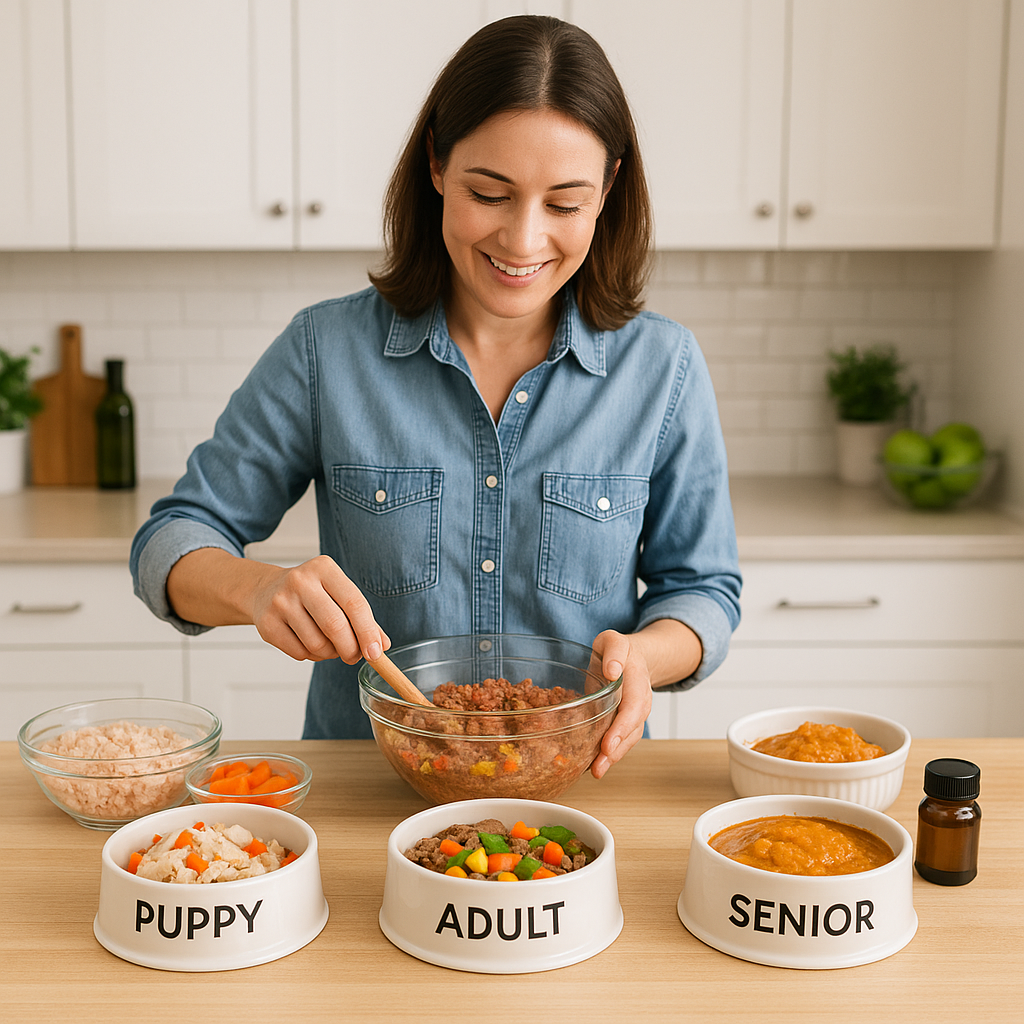
Why Life Stage Matters in Dog Nutrition
Dogs don’t just eat—they grow, play, heal, and age through their food. That’s why homemade dog food recipes should always be matched to your dog’s life stage. Nutritional needs vary significantly between puppies, adult dogs, and seniors.
Puppies require energy-dense diets with higher protein, calcium, and fat to support rapid growth. Adult dogs need balanced maintenance to prevent obesity while sustaining muscle and activity. Senior dogs often need more protein to combat muscle loss, plus joint support and easy-to-digest foods.
In my Ottawa clinic, I’ve worked with pet owners transitioning to homemade meals for reasons ranging from allergies to chronic disease to just wanting fresher food. When it’s done right—with veterinary guidance and a complete nutritional profile—homemade dog food can be safe, nourishing, and even life-changing.
Why this matters: Feeding a puppy a senior-style diet (or vice versa) can lead to serious deficiencies or excesses. Matching your homemade dog food recipes to your dog’s age helps avoid problems like poor growth, obesity, arthritis, or nutrient imbalances.
Puppy Recipes – Growth & Development
Homemade dog food recipes for puppies must meet the intense demands of growth. Puppies grow fast, which means their diet must deliver more calories, protein, and minerals—especially calcium and phosphorus—than adult dogs need.
Puppy Nutrient Needs (incl. AAFCO Minimums)
According to AAFCO, the minimum protein content for growth diets is 22.5% (dry matter) and 8.5% fat. Calcium and phosphorus must also be present in precise amounts (1.2–1.8% calcium and 1.0–1.6% phosphorus, with a Ca:P ratio between 1:1 and 2:1).
Vet insight: I’ve seen puppies with bowed legs or joint deformities due to unbalanced homemade diets—usually lacking calcium or containing excess phosphorus. That’s why it’s essential to follow recipes created by veterinary professionals and include supplements when advised.
AAFCO Dog Food Nutrient Profiles: https://www.aafco.org/
Key nutrients puppies need:
- High-quality animal protein (chicken, beef, eggs, etc.)
- Essential fatty acids for brain and skin health (e.g., fish oil)
- Calcium and phosphorus for bone development
- Added DHA for neurological development
- Adequate calories to fuel rapid growth
Safe Ingredients & Foods to Avoid
Safe ingredients for homemade dog food recipes for puppies include:
- Lean meats: chicken, turkey, beef (fully cooked)
- Whole grains: rice, oats
- Healthy fats: canola oil, fish oil (for DHA)
- Veggies: carrots, pumpkin, green beans, spinach (cooked/pureed)
- Dairy: plain yogurt or cottage cheese in moderation
- Eggs: cooked (never raw)
Toxic or risky ingredients to strictly avoid:
- Chocolate, grapes/raisins, onions, garlic, macadamia nuts, xylitol
- Excessive salt or seasoning
- Raw meats or eggs (high risk of pathogens in young dogs)
- Cooked bones (can splinter and cause internal injury)
- Unbalanced calcium-phosphorus sources (no bone-in meats without supervision)
Even some “natural” ingredients can cause harm if not balanced properly. I always recommend using a vet-designed recipe with a complete multivitamin and calcium supplement tailored for puppies.
Feeding Guidelines & Portioning Tips
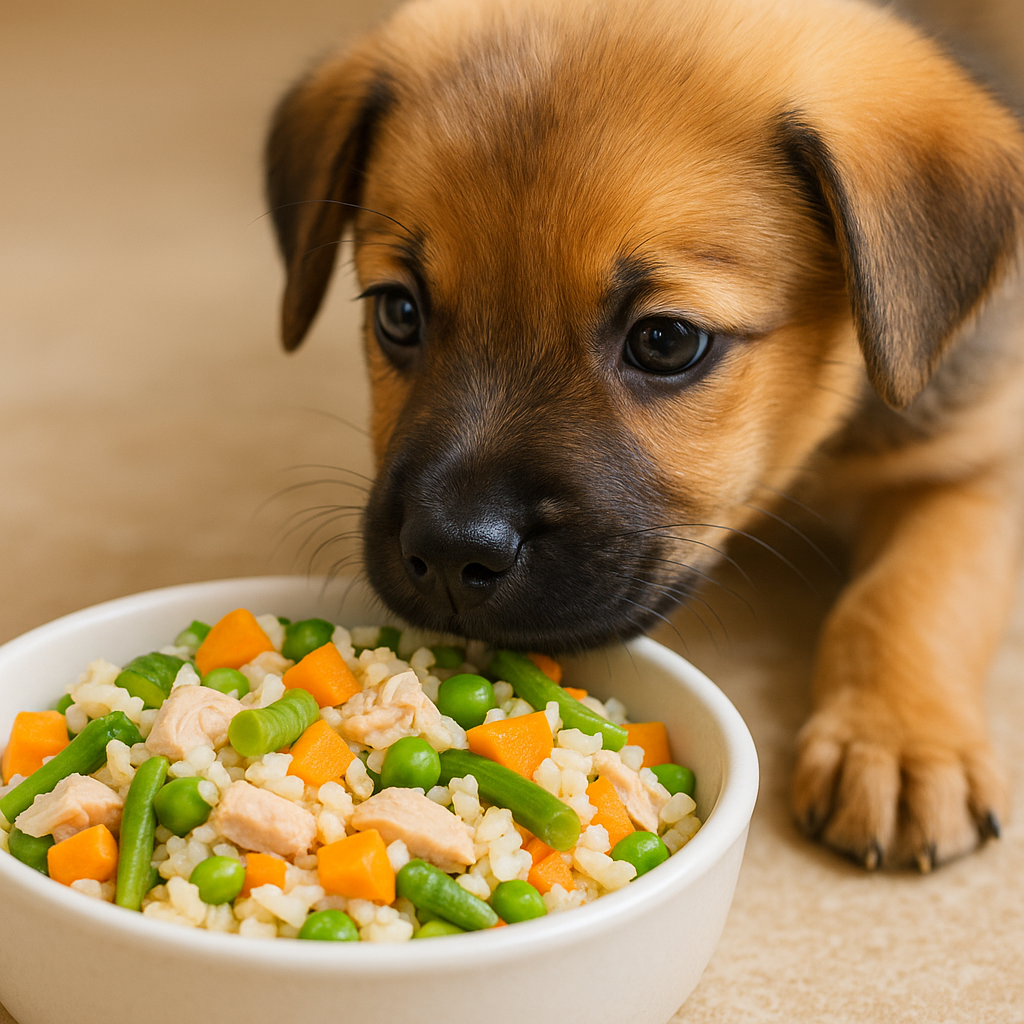
Puppies have small stomachs but big nutritional needs. That’s why homemade dog food recipes for puppies should be split into 3–4 meals per day until they’re about 6 months old.
How much to feed?
Use your puppy’s current weight and predicted adult weight to estimate daily caloric needs. A general starting point:
- 20 lb puppy = ~800–900 kcal/day (split into meals)
Portioning tips from my practice:
- Weigh your puppy weekly to track growth
- Adjust food quantities every 2–3 weeks as they grow
- Monitor for signs of overfeeding (rapid growth, soft stools) or underfeeding (weight stagnation, lethargy)
- Always provide fresh water
Use a kitchen scale to measure ingredients accurately. Homemade meals vary in calorie density, so eyeballing is risky. If you’re unsure, your vet can calculate ideal daily calories and gram-based meal sizes.
Also see: https://doglifeexpert.com/why-a-balanced-diet-matters-for-dogs/
5-Minute Home Checklist for Puppy Meals
Before you serve homemade dog food recipes for puppies, run through this quick checklist to ensure safety and balance:
✅ Is the protein source fully cooked and chopped small?
✅ Did you include a calcium source or puppy-specific supplement?
✅ Are the fats and oils puppy-safe (fish oil, canola, etc.)?
✅ Did you avoid harmful ingredients like onions, garlic, or raw bones?
✅ Is the food portioned properly for your puppy’s size and age?
✅ Are you storing leftovers in the fridge or freezer safely?
✅ Have you introduced only one new ingredient at a time?
✅ Did you consult your vet or a vet nutritionist?
Tip: Keep a notebook or app log of what your puppy eats and how they respond—this helps catch any intolerances or imbalances early.
Balanced Chicken & Rice Puppy Recipe
This homemade dog food recipe is formulated to support growth in small- to medium-breed puppies. It includes appropriate levels of protein, fat, and supplements to align with AAFCO puppy guidelines.
🐶 Chicken & Rice Puppy Meal (Makes 2 servings)
Ingredients:
- 6¾ oz cooked chicken breast, chopped
- 80 g cooked white rice
- 3 tsp canola oil
- ½ mL fish oil (DHA source)
- ⅓ tsp iodized salt
- Puppy multivitamin supplement (as directed per product, e.g. Balance IT Growth or similar)
Instructions:
- Mix the chopped chicken, cooked rice, and oils together.
- Sprinkle in the salt and mix thoroughly.
- Add the prescribed supplement amount and stir until evenly distributed.
- Serve half now, refrigerate the rest. Discard any uneaten food after 48 hours.
Why it works:
This recipe provides high-quality protein, digestible carbs, essential fatty acids, and critical minerals like calcium and iodine. With the added supplement, it forms a complete and balanced puppy diet.
Important: Always adjust quantities based on your puppy’s weight and check with your vet.
Typical Puppy Diet Costs in Canada
Feeding your puppy homemade dog food recipes can be affordable—especially for small breeds—but there are some key costs to factor in.
| Expense | Estimated Monthly Cost (Small-Med Puppy) |
|---|---|
| Chicken, rice, oils, vegetables | $60–$90 CAD |
| Fish oil (DHA) supplement | $10–$20 CAD |
| Puppy multivitamin supplement | $25–$35 CAD |
| Food-safe containers, prep tools | $10–$20 CAD (one-time setup) |
| Optional: Vet nutritionist consult | $150–$300 CAD (initial consult) |
Pro tip from clinic experience: Many owners find that batch cooking weekly and freezing portions saves money and time. Investing in a veterinary-formulated supplement is essential—it’s not optional if you’re making meals from scratch.
Adult Dog Recipes – Maintenance Mode
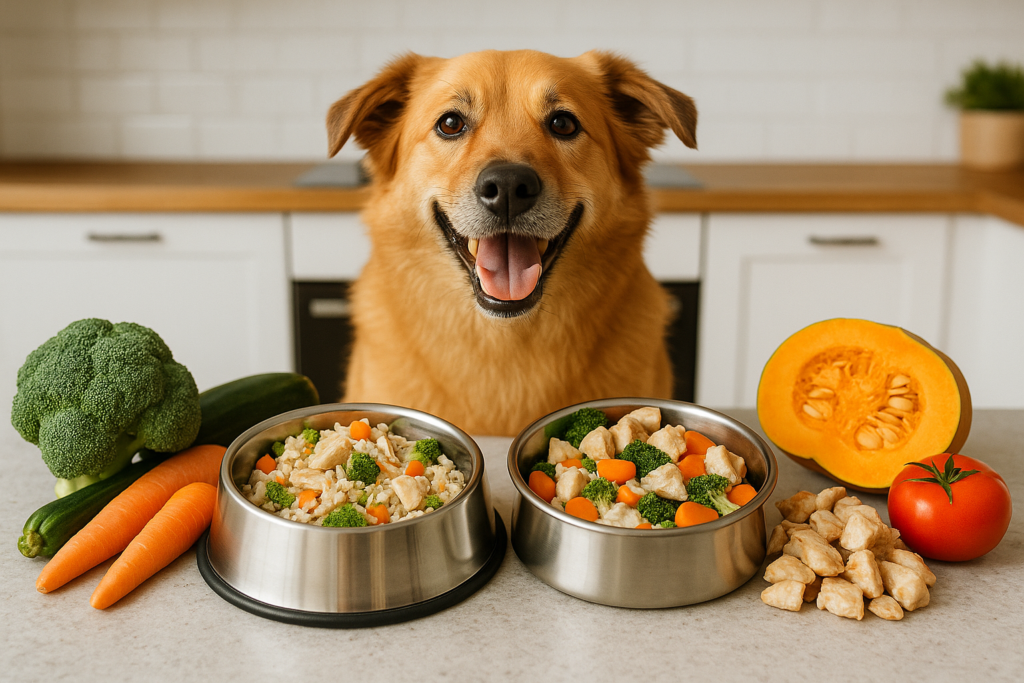
As dogs reach adulthood (usually around 12 months for most breeds), their nutritional focus shifts from growth to sustaining health and body condition. Homemade dog food recipes for adults should maintain muscle mass, support energy needs, and prevent weight gain.
Macronutrient Targets for Adults
According to AAFCO adult maintenance guidelines, adult dogs need at least:
- 18% protein (dry matter basis)
- 5.5% fat
- Balanced vitamins, minerals, and amino acids
Veterinary tip: In practice, I recommend aiming for 20–30% protein for healthy adult dogs, especially active ones. The exact ratio depends on breed, lifestyle, and health status.
Key nutrient goals:
- Adequate protein from lean meats, eggs
- Moderate fat for energy and skin health
- Carbohydrates for fiber and digestibility (though not essential)
- Micronutrients from vegetables and supplements
Ingredients to Use or Avoid
When creating homemade dog food recipes for adult dogs, aim for balance and simplicity. Here’s a vet-approved breakdown:
Good Ingredients to Include:
- Proteins: cooked chicken, turkey, lean beef, fish, or eggs
- Carbs: brown rice, oats, barley, sweet potatoes, pumpkin
- Veggies: green beans, carrots, spinach, broccoli (steamed or pureed)
- Fats: canola oil, olive oil, fish oil (supports coat and joints)
- Dairy: plain yogurt or cottage cheese, if tolerated
- Supplements: calcium source (e.g. eggshell powder), multivitamin (like Balance IT Canine), as needed
Ingredients to Avoid:
- Toxins: chocolate, grapes, onions, garlic, macadamia nuts, xylitol
- Overly fatty scraps (risk of pancreatitis)
- Cooked bones
- High-sodium foods (e.g. deli meats, salted broth)
- Raw dough or batter
Note from my clinic: Adult dogs often do well with food variety, but only if introduced gradually and monitored for sensitivity. Keep meals consistent during transitions.
Feeding Schedules & Adjusting Calories
Adult dogs thrive on routine and portion control. Overfeeding is one of the most common issues I see in-clinic—and it’s often unintentional.
Basic Feeding Guidelines:
- Feed twice a day (morning and evening) to support digestion and energy
- Monitor body condition using the rib-check and waist tuck method
- Adjust portions based on weight, age, breed, and activity level
Calorie estimates (per day):
- 10 lb dog: ~200–300 kcal
- 25 lb dog: ~500–600 kcal
- 50 lb dog: ~900–1200 kcal
- 75 lb dog: ~1200–1500 kcal
Use a calorie calculator or consult your vet for personalized targets.
Keep in mind: homemade dog food recipes may vary in calorie density. Always measure portions by weight, not volume alone, especially when switching protein or fat sources.
Clinic tip: Weigh your dog monthly at home or during visits. Small changes in weight can signal needed adjustments.
Balanced Chicken & Veggie Adult Recipe
This homemade dog food recipe supports maintenance in adult dogs and is adapted from veterinary hospital samples. It’s nutritionally complete when paired with a canine multivitamin supplement.
🦴 Chicken & Veggie Adult Maintenance Meal (Daily for ~15 lb dog)
Ingredients:
- 3 oz cooked dark meat chicken, skinless
- 1⅓ cups cooked white rice
- 1 tbsp mixed vegetables, steamed (e.g. peas, carrots, green beans)
- 1–2 tsp vegetable oil (canola or sunflower)
- 1½ scoops of Balance IT Canine supplement (or equivalent vet-recommended blend)
Instructions:
- Cook chicken and chop finely.
- Steam veggies until soft.
- Mix chicken, rice, veggies, and oil thoroughly.
- Add the supplement and stir until well combined.
- Split into two meals and refrigerate leftovers.
Why it works:
Provides balanced protein, carbs, healthy fats, and all essential vitamins and minerals with the supplement. Chicken thigh meat offers slightly more fat than breast, which helps maintain adult dogs’ calorie needs.
Adjust for weight:
Double this recipe for a 30 lb dog or halve it for a 7–8 lb dog. Always watch for changes in weight, coat, or stool quality to adjust accordingly.
Sample Monthly Cost Table (Canada)
Feeding homemade dog food recipes for adult dogs involves ongoing costs that vary by dog size and ingredient choices.
| Expense | Estimated Monthly Cost (15 lb Dog) | Estimated Monthly Cost (50 lb Dog) |
|---|---|---|
| Chicken, rice, vegetables | $80–$110 CAD | $180–$220 CAD |
| Vegetable & fish oils | $15–$25 CAD | $25–$35 CAD |
| Multivitamin/mineral supplements | $25–$40 CAD | $40–$60 CAD |
| Containers and storage | $10–$20 CAD (one-time) | $10–$20 CAD (one-time) |
| Vet nutrition consult (optional) | $150–$300 CAD (one-time) | $150–$300 CAD (one-time) |
Savings tip: Bulk buying and batch cooking significantly lower these costs. Also, many supplements last multiple months, reducing monthly expense.
Senior Dog Recipes – Golden Years
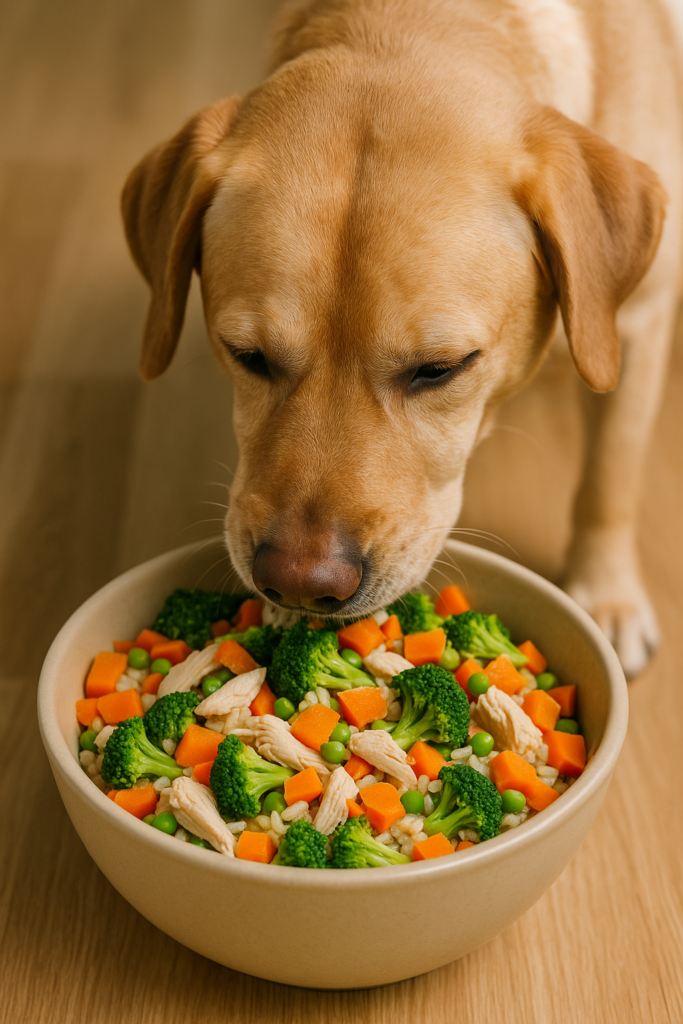
Senior dogs require special care in their homemade dog food recipes to support aging bodies, maintain muscle, and manage health issues like arthritis or kidney disease.
Key Dietary Adjustments for Seniors
- Higher protein levels (28–32% dry matter) to preserve muscle mass
- Lower calorie density to prevent obesity due to slower metabolism
- Increased fiber to support digestion and regularity
- Addition of joint-supporting nutrients such as glucosamine, chondroitin, and omega-3 fatty acids
- Careful management of sodium, phosphorus, and fat depending on medical conditions
Veterinary insight: I’ve seen many older dogs regain vitality on diets richer in protein and omega-3s, with softer textures to accommodate dental issues.
Joint, Kidney, or Weight Concerns
Many senior dogs face specific health challenges that homemade dog food recipes must address:
- Joint Health: Include omega-3 fatty acids (from fish oil), glucosamine/chondroitin supplements, and anti-inflammatory ingredients to ease arthritis.
- Kidney Disease: Limit phosphorus, moderate protein quality and quantity, and avoid high-sodium foods. Use vet-approved renal supplements.
- Weight Management: Lower calorie intake and reduce starchy carbs while maintaining sufficient protein. Smaller, more frequent meals help control appetite and digestion.
Note: Always consult your veterinarian before adjusting homemade diets for medical conditions.
Feeding Frequency & Monitoring Tips
Senior dogs often benefit from 2–3 smaller meals per day to improve digestion and maintain steady energy. This also helps if your dog has reduced appetite or dental problems.
Tips from practice:
- Add warm water or low-sodium broth to meals for hydration.
- Monitor weight every 2–4 weeks to catch unintentional loss or gain.
- Watch stool quality and coat condition as health indicators.
- Adjust portion sizes based on activity and health changes.
- Encourage hydration by providing fresh water at all times.
If your senior dog shows changes in appetite, energy, or bathroom habits, contact your vet promptly.
Senior-Friendly Soft Turkey Stew Recipe
This gentle homemade dog food recipe is ideal for seniors needing easy-to-digest, soft meals with balanced nutrients.
🦃 Soft Turkey & Rice Stew (Makes ~4–5 servings)
Ingredients:
- 1 lb lean ground turkey (or chicken/venison)
- 2 cups peeled, diced sweet potatoes
- 1 cup mixed veggies (broccoli, carrots, cauliflower), diced
- 1 tbsp dried rosemary (optional)
- 6 cups water or low-sodium bone broth (no onion/garlic)
- Senior multivitamin supplement or crushed eggshells for calcium
Instructions:
- Combine turkey, sweet potatoes, rosemary, and water/broth in a pot. Bring to boil.
- Reduce heat and simmer 20 mins, stirring occasionally.
- Add mixed veggies and simmer another 5 mins until soft.
- Cool, then add supplements.
- Serve lukewarm. Store leftovers refrigerated 2–3 days or freeze portions.
Why it works: High protein, hydrating, easy to chew, with fiber and antioxidants. Great for picky or sensitive senior dogs.
Homemade Diet Prep Tips & Safety
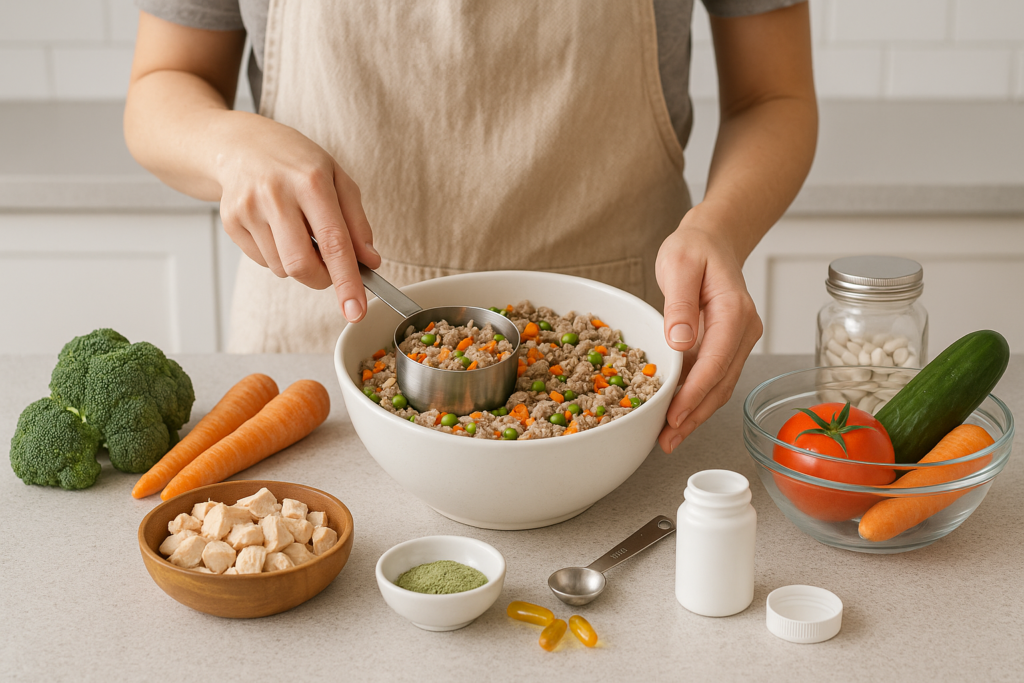
Making homemade dog food recipes is rewarding but requires careful preparation to keep your dog safe and healthy.
Cooking, Hygiene, and Storage
- Wash hands, utensils, and surfaces before and after food prep to prevent bacterial contamination.
- Cook meats thoroughly to safe temperatures, especially for puppies and seniors.
- Store leftovers in airtight containers in the fridge for up to 3 days or freeze for longer storage (up to 2 months).
- Avoid cross-contamination with human foods, especially raw meats.
- Use a kitchen scale to measure ingredients for accuracy.
How to Use Supplements Properly
- Follow supplement dosage instructions precisely.
- Mix supplements evenly into the food to prevent selective eating.
- Avoid skipping supplements—homemade diets often lack nutrients without them.
- Consider veterinary guidance or a nutritionist for personalized supplement plans.
Transitioning Diets Smoothly
- Gradually introduce new homemade dog food recipes over 7–10 days by mixing with current food.
- Introduce one recipe or ingredient at a time to monitor for adverse reactions.
- Watch for changes in appetite, stool, or energy during transitions.
FAQs – Homemade Dog Food
Q1: Is homemade dog food better than commercial kibble?
Homemade dog food recipes can be fresher and tailored to your dog’s needs but must be nutritionally balanced. Commercial diets are regulated for completeness. Consult your vet before switching.
Q2: Do I need a veterinary nutritionist to make homemade food?
It’s highly recommended, especially for puppies and dogs with health issues, to ensure recipes meet all nutrient requirements safely.
Q3: What supplements do homemade dog food recipes need?
Most need calcium, vitamins, minerals, and sometimes omega-3s. The exact mix depends on the recipe; always use vet-approved supplements.
Q4: Can I batch cook and freeze homemade dog food recipes?
Yes! Batch cooking saves time and maintains freshness. Freeze in portions, thaw in the fridge, and use within 2 months for best quality.
Q5: How do I know if my dog’s homemade diet is balanced?
Signs include a shiny coat, good energy, regular stool, and stable weight. Regular vet check-ups and possible blood tests confirm overall health.
Conclusion
Homemade dog food recipes can nourish your dog through every life stage—puppy, adult, and senior—when thoughtfully prepared. By tailoring recipes to meet the unique nutritional needs of each stage, you support healthy growth, maintenance, and graceful aging.
Always consult your veterinarian before making changes, use vet-approved recipes, and never skip necessary supplements. With proper planning, preparation, and regular monitoring, you can confidently serve fresh, balanced, and safe meals your dog will love.
Remember, your dog’s health is worth the extra effort—homemade dog food recipes done right make a difference.

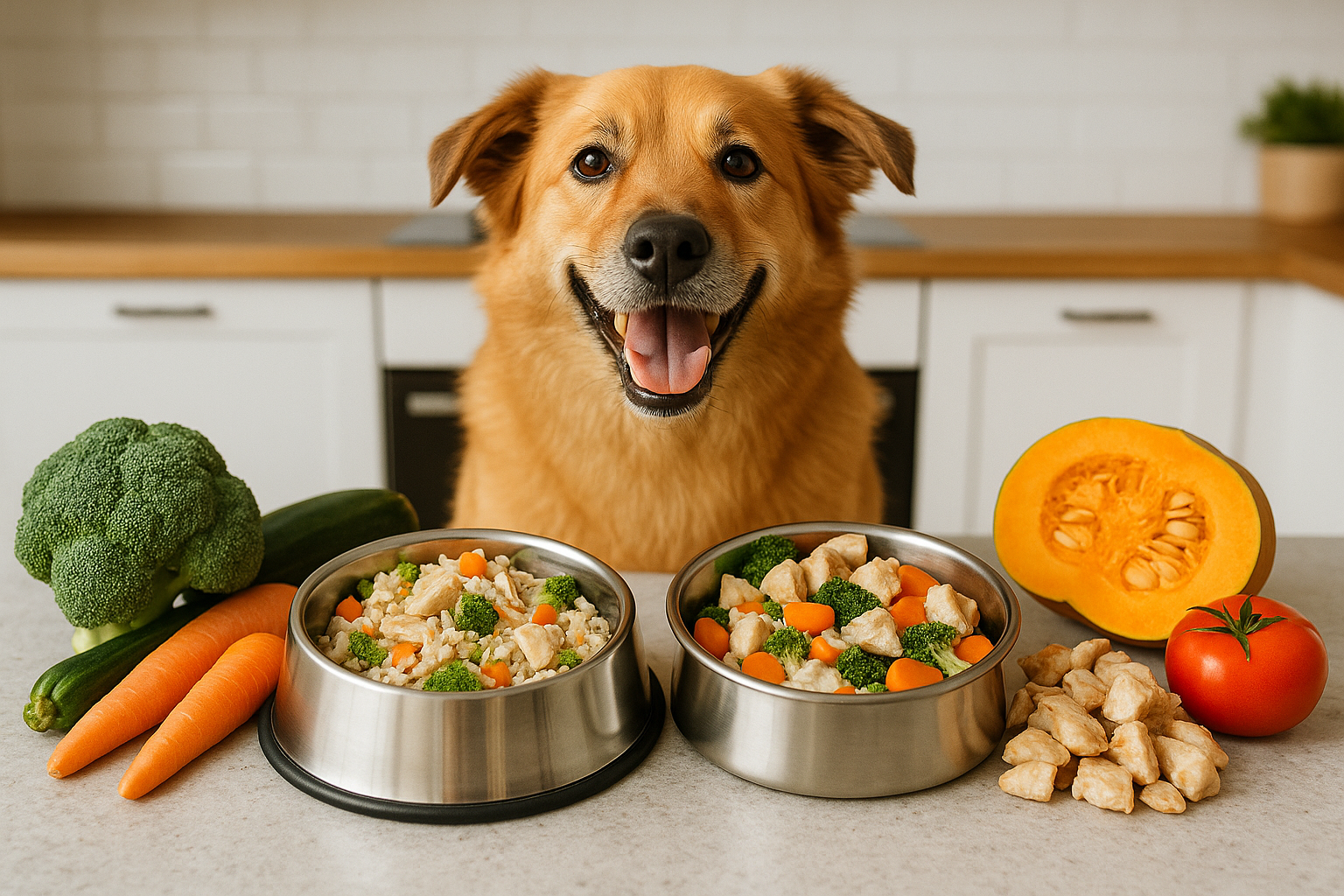



Pingback: Why a balanced diet matters for dogs
Pingback: Best Dog Food for Allergies: Vet Advice & Diet Tips 2025